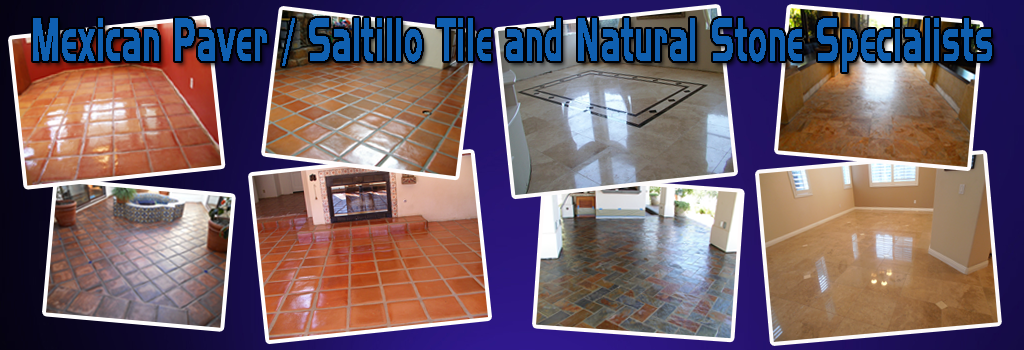 Your home’s tile or natural stone flooring is a relatively large investment yet one with a good return. It’s almost guaranteed to add value to your home. Taking care of it isn’t hard, but knowing how to care for it properly is the key to a long lasting and beautiful floor.
Your home’s tile or natural stone flooring is a relatively large investment yet one with a good return. It’s almost guaranteed to add value to your home. Taking care of it isn’t hard, but knowing how to care for it properly is the key to a long lasting and beautiful floor.
All Floors
Sweeping / Vacuuming
Dirt adheres easily to the surface of ceramic, porcelain and natural stone floors, especially styles with textured surfaces. Regular sweeping or dry dust mopping loosens and removes most dirt. A vacuum cleaner should also be used to sweep, especially before mopping. If you mop without vacuuming, any remaining dirt left behind by the sweeping process, gets moved around and usually ends up in your grout. Be sure to use a vacuum without a beater bar to avoid dulling and scratching the tiles. Floor cleaning attachments are great to suck up dirt along edges or in between tiles. Avoid “Swiffer” type” cleaning tools, especially “Wet Swiffers”. While these tools work well on wood, laminate or other floors without grout joints, on floors with grout joints, they simply move dirt from the tile and drop it in the grout.
Mopping
Vacuum floors thoroughly before mopping. Ceramic, porcelain and natural stone floors should be damp-mopped using surface specific, manufacturer-recommended cleaners. For heavier soil, spot clean the floor with a sponge or clean cloth using the same recommended cleaners. After cleaning, rinse thoroughly with clean, warm water to remove leftover residue, and wipe dry for a sparkling shine.
Heavy Cleaning
Mild scrubbing with a soft brush or electric polisher/scrubber and a mild surface specific cleaning solution may be required for textured or heavily soiled floors. After cleaning, rinse thoroughly with clean, warm water to remove leftover residue, and wipe dry for a sparkling shine.
Scuff Marks
Most flooring material will encounter scuff marks from shoes or furniture. Try using a “Mr. Clean Magic Eraser” to remove them. Wet the eraser with warm water and wring out slightly. Using light pressure, rub in a circular motion to remove these scuffs. Using too much pressure may dull your floors shine.
Mats
Using doormats on both sides of all entries is a great way to keep dirt being from coming into your home. Shake out or vacuum them often. This will reduce the amount of dirt being tracked across your tile or natural stone floor, and will reduces the wear to the finished surface.
Caulking and Sealing
Once your tile has been laid and grouted, it’s your responsibility to caulk areas that may be exposed to water. Caulking will help prevent expensive subsurface damage and keep the tiled areas looking as good as new. It will also reduce the risk of baseboard swelling damage due to moisture absorption. Use a high quality silicone caulk for this purpose. White caulking matches well to baseboards painted white. Colored, sanded caulking is also available in most grout colors to match your floors grout color.
Natural Stone Floors
Here’s some advice on cleaning and caring for your natural stone flooring:
Mopping
Damp mopping your natural stone floor will help keep it looking beautiful, but it is imperative that you use “PH Neutral” cleaners meant specifically for stone floors. Many common foods and drinks contain acids that will etch or dull the surface of many stones, and even the best stone sealers will not protect against acid staining. (Etching) Wipe up spills immediately. Use “stone safe” cleaners, not detergent for good-old fashioned mopping. One ounce of cleaned per two gallons should be sufficient for normal cleaning. Too much cleaner may leave a film and cause streaks, so rinse well. Change your rinse water frequently. After cleaning, rinse well and wipe dry for a sparkling shine. Don’t use products that contain lemon juice, vinegar, bleach, ammonia or acids. Never mix bleach and ammonia. This combination creates a toxic and lethal gas. Avoid abrasive cleaners. These products will dull your floor’s luster.
Furniture Moving
DO NOT drag any furniture across natural stone floors. Lift, don’t drag items into their final position. This will help to avoid chipping, scratching, or scuffing. Pad the feet of your furniture with felt pads to further guard against damage. Chairs or other furniture items with wheels should be be equipped with “hardsurface” rubber or urethane wheels. Most office chairs come with “carpet” wheels. These are made from hard plastic and will
eventually damage your stone floors.
Remember that each stone has its own level of porosity. The more porous the stone, the more likely it will stain. Keeping your stone floors properly sealed will prolong its life and enhance its beauty.
Mexican Tiles
Assuming your Mexican tile floor is sealed with a topical sealer, you can confidently follow the advice provided below. If your tile is sealed with a penetrating type sealer or is unsealed, you’ll need to be more cautious about what you use to clean the floor so as not to stain the raw clay.
Inspection
After carefully sweeping and vacuuming, inspect your floor for hairline cracks, recent chips, or lime pops. If you find these characteristics, it’s best to apply a couple coats of Saltillo floor sealer in those areas to prevent the clay from deteriorating. Ideally, this should be done a day or two before mopping to allow the new sealer time to dry. If you do this right after mopping, you will trap in the moisture from the mopping procedure and cause further damage.
Mopping
Clean the floor with cool water using a mild neutral cleaner solution. We recommend diluting most cleaners in order to preserve the life of the sealer. (1 ounce per 2 gallons water) Using hot water, steam mops or cleaners that are too strong will actually start to strip the sealer from your floor. This may eventually lead to moisture damage.
Floor Care DO’s ad DON’Ts
DO Dust mop floors frequently
DO Clean surfaces with mild detergent or stone soap
DO Thoroughly rinse and dry the surface after washing.
DO Blot up spills immediately
DO Protect floor surfaces with non-slip mats or area rugs and countertop surfaces with coasters, trivets or placemats
DON’T Use vinegar, lemon juice or other cleaners containing acids on marble, limestone, travertine or onyx surfaces DON’T Use cleaners that contain acid such as bathroom cleaners, grout cleaners or tub & tile cleaners DON’T Use abrasive cleaners such as dry cleansers or soft cleansers DON’T Mix bleach and ammonia; this combination creates a toxic and lethal gas DON’T Ever mix chemicals together unless directions specifically instruct you to do so STONE CLEANING and CARE Countertops Use coasters under all glasses, particularly those containing alcohol or citrus juices. Many common foods and drinks contain acids that will etch or dull the surface of many stones. Do not place hot items directly on the stone surface. Use trivets or mats under hot dishes and placemats under china, ceramics, silver or other objects that can scratch the surface. Floor Surfaces Dust mop interior floors frequently using a clean non-treated dry dust mop. Sand, dirt and grit do the most damage to natural stone surfaces due to their abrasiveness. Mats or area rugs inside and outside an entrance will help to minimize the sand, dirt and grit that will scratch the stone floor. Be sure that the underside of the mat or rug is a non-slip surface. Normally, it will take a person about eight steps on a floor surface to remove sand or dirt from the bottom of their shoes. Do not use vacuum cleaners that are worn. The metal or plastic attachments or the wheels may scratch the surface. Other Surfaces Clean stone surfaces with few drops of neutral stone soap cleaner. Black Diamond products are available at Ace Hardware store in Palm Desert. Use a clean cotton blend string mop on floors for best results. Too much cleaner or soaps may leave a film and cause streaks. Black Diamond products are “No Rinse”. Do not use products that contain lemon, vinegar or other acids on marble or Limestone. Change the rinse bucket water frequently. Do not use scouring powders or creams. These products contain abrasives that may scratch the surface. Bath and other wet areas In the bath or other wet areas, soap scum can be minimized by using a squeegee after each use. To remove soap scum, use a non-acidic soap scum remover.







